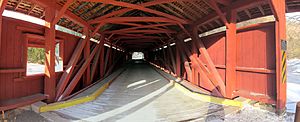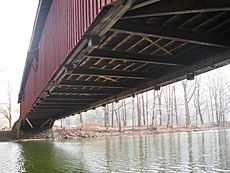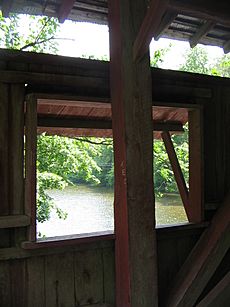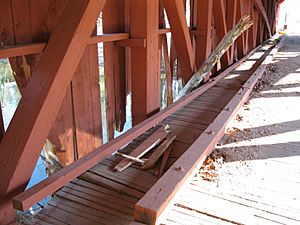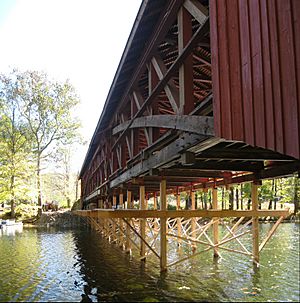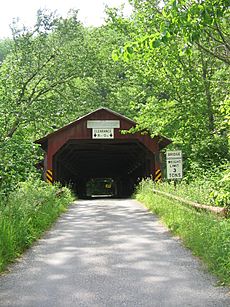Hillsgrove Covered Bridge facts for kids
Quick facts for kids Hillsgrove Covered Bridge |
|
|---|---|
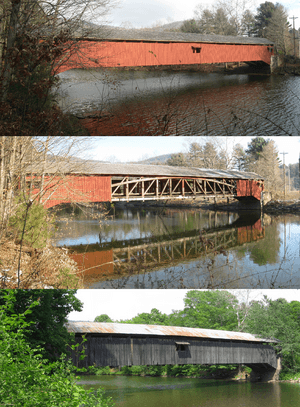
Hillsgrove Covered Bridge over Loyalsock Creek after restoration in 2012 (top), with flood damage in 2011 (middle), and before restoration in 2008 (bottom)
|
|
| Coordinates | 41°27′39″N 76°40′15″W / 41.46083°N 76.67083°W |
| Carries | TR 357 |
| Crosses | Loyalsock Creek |
| Locale | Sullivan, Pennsylvania, United States |
| Official name | Hillsgrove Covered Bridge |
| Other name(s) | Rinkers Covered Bridge |
| Named for | Hillsgrove Township |
| Maintained by | Sullivan County |
| NBI Number | 567207035700040 |
| Characteristics | |
| Design | National Register of Historic Places |
| Total length | 186 ft (57 m) |
| Width | 18.0 ft (5.5 m) |
| Height | 8.0 ft (2.4 m) |
| Load limit | 3 tons (2.7 t) |
| History | |
| Constructed by | Sadler Rodgers |
| MPS | Covered Bridges of Bradford, Sullivan and Lycoming Counties TR |
| NRHP reference No. | 73001666 |
| Added to NRHP | July 2, 1973 |
| Lua error in Module:Location_map at line 420: attempt to index field 'wikibase' (a nil value). | |
The Hillsgrove Covered Bridge is a special kind of bridge called a covered bridge. It crosses Loyalsock Creek in Hillsgrove Township, Sullivan County, in the U.S. state of Pennsylvania. It was built around 1850 and is about 186 feet (56.7 m) long.
In 1973, it became the first covered bridge in Sullivan County to be added to the National Register of Historic Places (NRHP). This means it's an important historical site! The bridge is named after Hillsgrove Township and the nearby village. It's also known as Rinkers Covered Bridge because of a farm next to it.
Pennsylvania was the first state in the United States to have a covered bridge. It has had more of these bridges than any other state since the 1800s. Covered bridges were a step between stone bridges and metal ones. Their roofs and sides protected the wooden parts from bad weather, making them last longer.
The Hillsgrove bridge uses a special design called a Burr arch truss. This design uses strong wooden arches with vertical posts to make the bridge very sturdy. It was built by a person named Sadler Rodgers. He also built the nearby Forksville Covered Bridge in the same year, using a similar design.
The Hillsgrove bridge is the longest of only three covered bridges left in Sullivan County. It was once a place where lumber rafts would stop on the creek between 1870 and 1890. Even today, you can see old rules posted on the bridge about speed, how many animals can cross, and fire safety. The bridge has been repaired and restored several times, including in 1963, 1968, 2010, and 2012 after a big flood. It is still used today by cars and trucks.
Contents
Where is the Hillsgrove Covered Bridge?
The Hillsgrove Covered Bridge is located in Hillsgrove Township on Covered Bridge Road (Township Road 357). This road is just a short distance north of Pennsylvania Route 87. The bridge crosses Loyalsock Creek, about 2.6 miles (4.2 km) upstream from the village of Hillsgrove. It's also very close to Elkland Township.
The official name of the bridge on the National Register of Historic Places is Hillsgrove Covered Bridge. But many people also call it Rinkers Covered Bridge because of the Rinker farm located at its east end. Sullivan County is in north-central Pennsylvania. It's about 123 miles (198 km) northwest of Philadelphia and 195 miles (314 km) east-northeast of Pittsburgh.
The village of Hillsgrove has a long history. The first settler in what is now Sullivan County, Daniel Ogden, arrived there around 1786. John Hill, who founded the village of Hill's Grove (which later became Hillsgrove), came to the area in 1789. Sullivan County was created in 1847. The bridge was built just three years later, in 1850. The Hillsgrove Covered Bridge is named after its township and the nearby village. It even gave its name to a nearby old one-room school called the Bridge View School.
It's interesting to note that there was another covered bridge called Hillsgrove Covered Bridge. This one was also over Loyalsock Creek, but it was right in the village of Hillsgrove. It stood from 1876 until 1934, when it was replaced by a modern steel and concrete bridge. That bridge was actually the third covered bridge at that spot!
The History of Covered Bridges
Why Covered Bridges Were Built
The very first covered bridge in the United States was built in 1800 in Philadelphia, Pennsylvania. Pennsylvania is thought to have had the most covered bridges in the country between 1830 and 1875, with an estimated 1,500 at one point. By 2001, Pennsylvania still had more historic covered bridges than any other state, with 221 remaining.
Covered bridges were important because they helped people move from using stone bridges to using metal ones. In the 1800s, wood was easy to find in Pennsylvania and was great for building bridges. However, wood doesn't last long when it's exposed to rain, snow, and sun. The roof and enclosed sides of covered bridges protected the wooden parts. This allowed these bridges to last for more than a hundred years!
How the Hillsgrove Bridge Was Built
The Hillsgrove bridge, like the other two remaining covered bridges in Sullivan County, was built around 1850. It uses a special design called a Burr arch truss. This design combines a strong arch with multiple vertical posts, making the bridge much stronger and stiffer.
The Hillsgrove bridge was built for Sullivan County by Sadler Rodgers. He was only 18 years old at the time! He also built the Forksville bridge in the same year. Both the Forksville and Hillsgrove bridges cross Loyalsock Creek. The Hillsgrove bridge is about 5 miles (8 km) downstream from the Forksville bridge.
On July 2, 1973, the Hillsgrove bridge became the first covered bridge in Sullivan County to be added to the National Register of Historic Places (NRHP). This was a big step in recognizing its historical value.
What the Bridge Looks Like
The Hillsgrove bridge is 186 feet (56.7 m) long. The maximum weight allowed on the bridge is 3.0 short tons (2.7 t) (3 short tons). The bridge's roadway is wide enough for one lane of traffic.
As of 2015, there are signs at each entrance that show the clearance height is 8 feet (2.4 m). There's also an old sign from the 1800s that lists rules for using the bridge. It says things like: "All persons are forbidden to ride drive or lead any animal over this bridge faster than a walk or to drive more than 15 head of cattle horses or mules thereon at one time or to carry fire thereon except in a safe vessel under a penalty of not less than $.30 for each offence."
The bridge sits on stone and mortar supports, which have been made stronger with concrete. The bridge deck (the floor you drive on) is made of wooden planks. There are also wooden beams on the deck called "wheel guards" that separate the roadway from small walkways on the sides. These also protect the sides of the bridge.
The sides of the bridge are covered with vertical wooden boards. Both the inside and outside of the bridge are painted red. The bridge has long, narrow windows with wooden shutters. There are three windows on the south side and two on the north side. The roof is made of wooden shingles. The bridge's design is very similar to the Forksville Covered Bridge.
Using and Restoring the Bridge
Surviving Floods and Changes
In the 1800s, the Hillsgrove Covered Bridge survived major floods in 1865 and 1889. These floods destroyed other bridges in the area, showing how strong this bridge was!
Between about 1870 and 1890, the bridge was a stop for "lumber rafts" floating down Loyalsock Creek. These rafts carried huge amounts of cut wood. The bridge was known as "Uncle Ben's Landing" for these rafts. The era of lumber rafts ended when most of the large trees in the area were cut down.
The bridge has been repaired and restored many times over the years. In 1963, the bridge's deck was noted as being "a bit swaybacked," and it was "reconstructed." In 1968, a retired contractor named T. Corbin Lewis restored the bridge.
In the past, people in Sullivan County sometimes thought about tearing down old covered bridges. But by the late 1900s, attitudes changed. People realized how important these historic bridges were. The Hillsgrove Covered Bridge was added to the National Register of Historic Places in 1973. Now, the Pennsylvania Historical and Museum Commission must approve any major repair work on covered bridges listed on the NRHP.
Recent Restorations
In 2001, the United States Department of Transportation gave $360,000 to help restore the Hillsgrove bridge. This covered 80% of the costs! In 2010, the bridge had a big rehabilitation. Its metal roof was replaced with traditional cedar shingles. Workers also repaired the wooden structure, entrances, and sides. The bridge was cleaned and painted red. This rehabilitation cost $150,516, and the bridge reopened in the autumn of 2010.
However, in 2011, the bridge was badly damaged by major floods from Hurricane Irene and Tropical Storm Lee. The floodwaters carried debris into the bridge, ripping off much of the siding and damaging the structural beams. Two trees even got stuck inside the bridge! Both the Hillsgrove and Sonestown covered bridges had to be closed.
Sullivan County applied for and received money from the Federal Emergency Management Agency (FEMA) to fix both bridges. The Hillsgrove bridge was repaired first because it was an important route to a restaurant and was used a lot by hunters. The repairs included replacing broken beams, parts of the deck, and siding.
The restoration cost $250,000. The bridge was reopened on November 21, 2012, just in time for deer hunting season! A county commissioner, who had been married on the bridge 25 years earlier, helped reopen it.
Even after the 2010 restoration, the bridge was still rated as "Structurally Deficient" in 2012. This means it needed more work to meet modern standards, especially its railings and guardrails.
As of 2015, the bridge is still in use. About 54 vehicles crossed it each day in 2012. The bridge's post-flood restoration in 2012 even won an award for "Emergency Response." Many people, including tourists, enjoy visiting the Hillsgrove Covered Bridge. It is considered one of the most attractive covered bridges in Pennsylvania because of its beautiful setting.
Bridge Dimensions
Different groups have measured the Hillsgrove Covered Bridge over the years, leading to slightly different numbers for its length, width, and load limits. Here's a comparison:
| Source | Year | Length feet (m) |
Width feet (m) |
Load short tons (MT) |
Name used |
|---|---|---|---|---|---|
| NBI | 2012 | 186 feet (56.7 m) | 12 feet 2 inches (3.71 m) | 5.0 short tons (4.5 t) | Hillsgrove |
| NRHP | 1980 | 171 feet (52.1 m) | 18 feet (5.5 m) | 3.0 short tons (2.7 t) | Hillsgrove |
| Evans | 2001 | 185 feet 8 inches (56.59 m) | 15 feet (4.6 m) | NA | Hillsgrove, Rinkers |
| Zacher | 1994 | 152 feet (46.3 m) | 18 feet (5.5 m) | NA | Hillsgrove |


